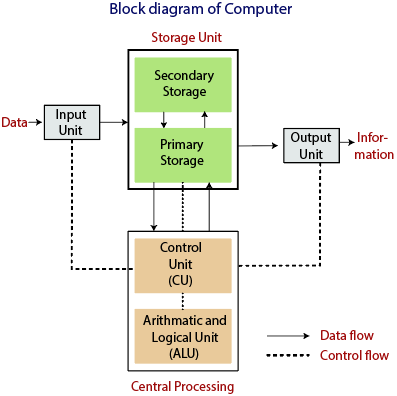Block Diagram of Basic Organization of Computer System – This book covers the entire syllabus of “Computer & Information Technology” prescribed by the BNMC for B.Sc. in Nursing Science & Diploma in Nursing Science & Midwifery students. We tried to accommodate the latest information and topics.
This book is an examination setup according to the teachers’ lectures and examination questions. We hope in touch with the book students’ knowledge will be upgraded and flourished. The unique way of presentation may make your reading of the book a pleasurable experience.
Block Diagram of Basic Organization of Computer System
Function of Computer:
All computer systems perform the following five basic functions for converting raw input data into useful information and presenting it to a user:
1. Inputting. It is the process of entering data and instructions into a computer system.
2. Storing. It is the process of saving data and instructions to make them readily available for initial or additional processing as and when required.
3. Processing. Performing arithmetic operations (add, subtract, multiply, divide, etc.), or logical operations (comparisons like equal to, less than, greater than, etc.) on data to convert them into useful information is known as processing.
4. Outputting. It is the process of producing useful information or results for a user, such as printed report or visual display.
5. Controlling. Directing the manner and sequence in which the above operations are performed is known as controlling.

Another Answer
The four functions of a computer actually explain the core reasons why it was built. They include:
1. Data input
2. Data processing.
3. Information output.
4. Data and information storage.
Data Input
Every computer is designed with data input as a first function, an activity which is accomplished via input devices.
Data entry is done manually, automatically or both. Manual input is done via add-on peripherals like the keyboard, mouse and stylus. Input can also be accomplished via vocal dictation applications and body gestures peripherals like Kinect and biometric devices. Elsewhere, data input is also done using secondary storage media and networking interfaces.
Application software used for this purpose will also dictate what data is entered. Word processing software is designed to input basic alphanumerical data, while a photo editing application is used to input and manipulate images.

Data Processing
Data processing is the core function of a computer. Processing involves manipulation of raw data into before converting it into meaningful information. Usually, data is in raw form, and will thus undergo processing before dissemination for user consumption.
The ‘brain’ of the computer where data is processed is referred to as the microprocessor. It is also commonly known as the central processing unit (CPU) or accelerated processing unit (APU).
The processing chips in modern personal computing devices continue to evolve and outperform its predecessors. One particular evolution is the merger of microprocessor and graphics processing unit (GPU) into what is now known as accelerated processing unit. The merger allows for the integration of powerful graphics processing abilities inside the traditional arithmetic and logical computations of the processor.
Besides the microprocessor, the dynamic random access memory (DRAM) and static random
access memory (SRAM) are integral parts of data processing. Data entered via input devices is stored temporarily in DRAM, then transferred to SRAM from where the microprocessor manipulates it.

Information Output
When raw data has been manipulated by the microprocessor, the outcome is meant to be disseminated for useful purposes. The output is thus referred to as information and is beneficial to the computer user.
Processed data or information can be,
- Viewed as alphanumeric, images and video via a display hardware
- Listened to as audio files by use of a speaker
- Printed as hard copy output onto paper
- Printed as 3D models
Data and Information Storage
The fourth and equally very important function of a computer is data and information storage. After sleepless nights of video and animation creation and editing, the user wants to have the finished product stored for future dissemination and additional editing.
A computer can store information internally and externally. The hard disk drive (HDD) and/or solid-state disk drive (SSD) are internal storage devices and serve to protect and house all data and information on a computer. In bigger systems, the RAID system is used. Multiple disk drives operate simultaneously to ensure data and information integrity.
External storage is achieved through accessories that attach externally to the computer. They include external drives and optical disks. Better still data and information can be stored online in cloud solutions for a fee or for a fee if large space is required.
Draw a block diagram of basic organization of computer system

Read more:
